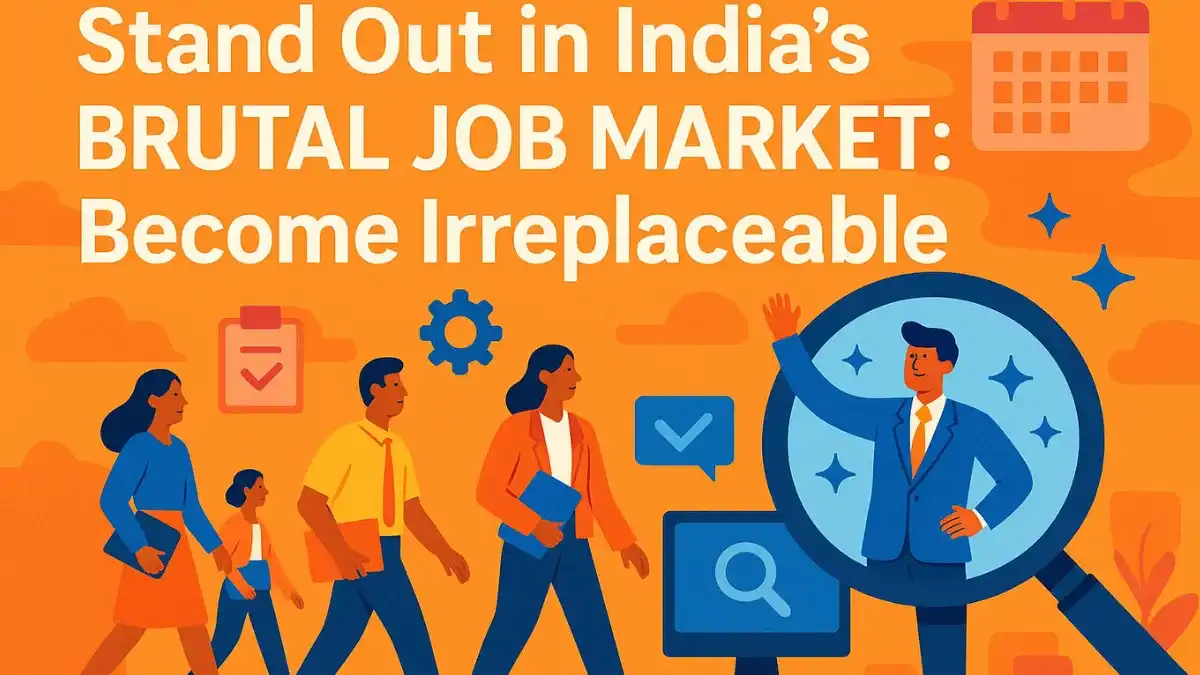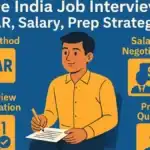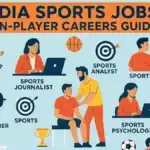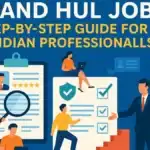## How to Stand Out in India Brutal Job Market (When Everyone Feels Replaceable)
Meet Priya. She’s sitting in a Bangalore cafe, scrolling through LinkedIn. Again. She sees her former classmate celebrating a promotion at a tech giant. Another connection shares their “dream job” announcement. Priya’s sent out 87 applications this month. She got three callbacks. Zero offers. The knot in her stomach tightens. “What’s wrong with *me*?” she wonders. “Am I just… invisible?”
Sound familiar? You’re not alone. India’s job market is a fierce arena. With lakhs of graduates entering every year and global uncertainties shifting industries overnight, standing out feels harder than ever. It’s not just about qualifications anymore. It’s about making employers *see* you, *remember* you, and *choose* you. The good news? You don’t need to be a genius or a celebrity. You need smart, actionable strategies. Let’s break down how you can transform from “just another applicant” to the “must-hire candidate,” whether you’re in Mumbai, Pune, Chennai, or beyond.
1. Stop Spraying Resumes & Start Building Your “Signature Story”
India Brutal Job Market, Rohan in Mumbai made a classic mistake. He used the same resume for every application – from content marketing roles to data analyst positions. Result? Silence. Why? Generic = Forgettable. Employers don’t hire skills; they hire people who solve their problems.
Your Action Plan:
- Become a Problem Detective: Before applying, research the company’s *real* pain points. Check their recent news, Glassdoor reviews, and even competitor activity. Did they just expand to Pune? Maybe they need someone who understands local markets. Struggling with customer retention? Highlight your experience in boosting engagement.
- Craft Your “Signature Story”: Connect your past experiences directly to their future needs. Instead of “Managed social media,” say “Grew Instagram engagement by 40% for an edtech startup targeting Tier-2 cities in 6 months, directly increasing lead quality.” See the difference? It’s specific, outcome-focused, and relevant.
- Show, Don’t Just Tell: Create a simple online portfolio. Even a free Google Drive folder with 2-3 key projects is better than nothing. For a marketing role? Include a campaign analysis. For a developer? Share a GitHub link to a clean code snippet. Platforms like Digital Smart Careers often emphasize showcasing tangible proof – it builds instant credibility.
2. Upskill Like a Strategist, Not a Sheep (Forget Random Coursera Certificates!)
Anjali in Pune spent lockdown collecting online certificates – Digital Marketing, Python Basics, UX Design. Yet, she’s stuck in her customer service role. Why? She learned skills, but not the *right* skills strategically aligned with where she wants to go.
Your Action Plan:
- Target Skills with “Traction”: Don’t follow generic “Top 10 Skills” lists. Look at *actual* job descriptions for your target role in your city. Use LinkedIn to see what skills people *already in those roles* are adding. Is AI prompt engineering suddenly hot in Bangalore fintech? Are sustainability reporting skills booming in Chennai manufacturing?
- Learn in Public (It’s Your Best Advertisement): Don’t just consume knowledge; share your learning journey. Start a simple LinkedIn post series: “My 30-Day Journey Learning Data Visualization.” Share one key takeaway daily. Comment intelligently on industry posts. This builds visibility and positions you as someone actively growing. Digital Smart Careers resources can guide this focused learning approach.
- Micro-Experiences Trump Mega-Courses: Instead of another 6-month generic course, can you volunteer for a small project using the new skill? Help a local NGO with their social media? Analyze data for a friend’s small business? Real-world application, however small, is gold on your resume.
3. Network Like a Human, Not a Robot (Especially If You Hate Networking)
Karan in Delhi thought networking meant adding hundreds of strangers on LinkedIn with a generic “Hi, connect please” message. Unsurprisingly, his connection requests gathered dust. Authentic networking isn’t about quantity; it’s about genuine connection.
Your Action Plan:
- The “Warm Intro” Hack: Leverage your existing network (friends, family, alumni) to find a *single* connection at your target company. Ask for a casual 10-minute chat (“I admire your work at [Company], could I ask for brief advice?”). People rarely say no to a genuine, low-pressure request for advice.
- Give Value First: Found an article relevant to someone’s recent post? Share it with a brief note. Can you introduce two people in your network who might benefit? Offering help *before* asking builds trust and goodwill.
- Attend Events with Purpose: Instead of trying to meet everyone at a big Mumbai job fair, target 2-3 people from specific companies. Research them beforehand. Have one insightful question ready about their work or company challenges. Follow up with a personalized LinkedIn message referencing your conversation.
4. Master the Interview “Close”: How to Be Unforgettable After “Any Questions?”
Vikram in Hyderabad aced the technical rounds. The hiring manager said, “Do you have any questions for us?” Vikram asked generic ones about work culture. He didn’t get the offer. Why? He missed the chance to truly differentiate himself.
Your Action Plan:
- Ask “Future-Back” Questions: Instead of “What’s a typical day like?” try: “Imagine it’s one year from now, and I’ve been incredibly successful in this role. What specific things would I have achieved?” This shows ambition and forces the interviewer to visualize *you* succeeding.
- Present a “Mini-Project”: Based on your research, prepare one actionable idea relevant to the role. “I noticed your app’s onboarding flow has a 30% drop-off at step 3. Based on my experience, here’s one low-effort tweak I’d test…” This demonstrates initiative and problem-solving instantly.
- The Powerful Follow-Up: Send a *personalized* thank-you email within 24 hours. Reference a specific point from the conversation and briefly reiterate how your unique skill (mention it!) solves their discussed challenge. Attach your idea as a simple one-pager. This makes you memorable long after other candidates fade.
5. Embrace the Hustle Mindset (Without Burning Out)
Standing out isn’t a one-time event; it’s a continuous practice. It’s easy to get discouraged by rejections in a tough market like India’s.
Your Action Plan:
- Track Your “Wins,” Not Just Applications: Maintain a simple spreadsheet. Instead of just logging applications, track: “Skills I showcased,” “New contact made,” “Interview feedback received,” “One thing I learned.” Seeing progress beyond offers keeps you motivated.
- Build Your “Personal Board of Directors”: Identify 3-5 trusted people (a mentor, a supportive peer, a former manager) who believe in you. Share your goals and setbacks with them regularly. Their perspective is invaluable when self-doubt creeps in.
- Schedule “Career Growth” Time: Treat your job search or skill-building like a crucial project. Block 2-3 dedicated, focused hours each week in your calendar – just for learning, networking outreach, or portfolio updates. Consistency beats chaotic effort. Digital Smart Careers frameworks often highlight this structured approach.
Feeling invisible in the job market chips away at your confidence. It makes you question your worth. But here’s the powerful truth: you are *not* your resume, your last rejection, or the job title you haven’t landed yet. Standing out isn’t about being the loudest; it’s about being the most intentional, the most prepared, and the most genuinely engaged. Priya, our friend from the Bangalore cafe? She started implementing these strategies. She stopped spraying resumes and focused on telling her unique story tied to company problems. She shared her upskilling journey publicly. She networked with purpose. It took time, but the callbacks turned into conversations, and the conversations turned into offers. She wasn’t magically transformed; she became strategically visible. The Indian job market is tough, yes. But it’s filled with opportunities for those who refuse to blend in. Your unique value exists. Now, go make sure the world sees it. You’ve got this.
Your Standing-Out Starter Pack
FAQs:
- Q: I have gaps in my resume. How do I handle that?
A: Be upfront but positive. Frame it as a period of skill-building, caregiving, or strategic reflection. Highlight relevant skills gained during that time (e.g., “During my career break, I managed a family project budget, honing my financial planning skills”). Focus energy on the value you offer NOW. - Q: How can I network if I’m shy or introverted?
A: Leverage digital first! Engage thoughtfully on LinkedIn (comment meaningfully on posts). Start small with 1:1 virtual coffee chats (less overwhelming than big events). Prepare questions beforehand. Introverts often excel at deep listening and building genuine connections – use that strength. - Q: Do I *really* need a personal brand? Isn’t that for influencers?
A: Your “personal brand” simply means how others perceive your professional value. Everyone has one! It’s about consistently communicating what you’re great at and how you solve problems. It makes you memorable and referable. - Q: How long does it take to see results?
A: It’s a marathon, not a sprint. Building visibility and credibility takes consistent effort. Focus on small wins (a great conversation, positive feedback, a new skill mastered). Significant traction often comes in 3-6 months of focused effort.
Must-Have Tools & Apps:
- LinkedIn Sales Navigator (Free Trial/ Lite Plan): Not just for sales! Filter and find *exact* hiring managers or people in your target roles/companies in specific cities like Pune or Gurgaon. Enables highly targeted outreach.
- Canva (Free): Create visually appealing one-pagers for your “mini-project” ideas, simple infographics summarizing your achievements, or a clean online portfolio. Makes your work stand out visually.
- Streak (Free for Gmail): A CRM inside Gmail. Track your job applications, set reminders for follow-ups, and see when your emails are opened. Essential for managing your outreach efficiently.
5 Quick Wins You Can Do TODAY:
- Revamp One Bullet Point: Pick one line on your resume. Rewrite it using the formula: “Accomplished [X] as measured by [Y] using [Z Skill].” Make it outcome-focused.
- Send One “Value First” Message: Find someone on LinkedIn in your target role/industry. Share a genuinely useful article or resource related to their recent post with a brief, personal note. No ask!
- Identify One “Traction Skill”: Scan 5 job descriptions for your dream role. What’s *one* specific skill mentioned repeatedly that you lack? Find *one* free resource (article, short video) to start learning it.
- Optimize Your LinkedIn Headline: Ditch “Job Seeker.” Use keywords like “Helping [Industry] achieve [Result] through [Your Skill].” (e.g., “Helping SaaS companies boost user retention through data-driven customer success strategies”).
- Block “Growth Time”: Open your calendar. Right now, block 90 minutes this week solely for focused career development (skill-building, strategic applications, networking prep). Protect this time fiercely.






